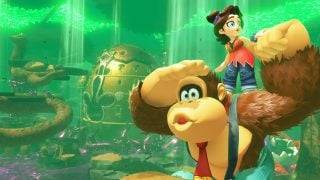I remember the moment very well. It was late 2001, or maybe early 2002, and I was playing Super Smash Bros. Melee with my older brother and sister. (For reference, I was five years old.) Having just unlocked Young Link, we immediately set out to clear Classic Mode with him, and upon doing so, were encountered by the familiar Warning! Challenger Approaching! Screen. Upon transitioning to the battle, we were greeted with a strange blue-haired swordsman, as a now-iconic track started up. After our victory, I distinctly remember saying out loud:
“Who the heck is Marth?”

My brother, knowledgeable in the then-enigmatic ways of the internet, looked it up. Apparently he was from some Japanese game called “Fire Emblem” we had never heard of. Some other guy named Roy was in the game also, and I reasoned that since he could actually use fire he was obviously a better representative. But even so, curiosity began to smolder within me – what were these weird Japanese swordsmen all about?
I had no idea then what future lay in store for me.
A little over a year or so later, in 2003, my brother picked up Fire Emblem for GBA, and after he was done, he handed it to me knowing that I had been interested in playing it. With a trusty Nintendo Power strategy guide in tow, I delved into the experience head first, beginning with getting to know Lyn and her struggles. I was six or seven at the time.

I can’t even count the number of times I played through that game. Better known as Fire Emblem 7 or Fire Emblem: Blazing Blade, it is, to this day, the title I probably revisit the most. At the time I knew just about one thing – “don’t let anybody die” – and nothing else. I didn’t understand a lick about supports, arenas, or weapon ranks. I barely grasped ideas like the weapon triangle or classes. But, spurred on by my love of earlier strategy games like Civilization, I pushed through, falling in love with so many characters in the meantime. The flame of my affection for Fire Emblem had been lit, kindled by a game that remains one of my all time favorites to this very day.
Yet after all that… FE7 remained my only real experience with the series for quite sometime. My Nintendo Power subscription ran out within the next year, and this was before I regularly browsed the internet, so I wasn’t even aware when The Sacred Stones and Path of Radiance came out. I did pick up Radiant Dawn when it released on Wii, but since I hadn’t played PoR the plot lost me and I couldn’t get into it. Prolonged playing of Smash Bros. and repeated playthroughs of FE7 kept my interest in the series alive, but it was more of a flickering affection than a blazing love. Until, ten years after I experienced Fire Emblem properly for the first time, one game changed everything.

The series had fallen on hard times. The Radiant games had sold poorly, mostly due to bad marketing (Radiant Dawn was released in North America on the same day as Super Mario Galaxy), and the DS remakes of FE1 and FE3 were lackluster at best, in no small part due to their uncanny-valley inducing artstyle and comparatively light story. Intelligent Systems was given a quota to match for the series’ 13th title – 250,000 units – or else it would be finished. While people often exaggerate the dourness of the situation (FE12, released only in Japan, barely met those numbers) the point of the fact is that the studio decided to throw everything they had into what could have been their last game. That title, a celebration of all of Fire Emblem, came to have the subtitle of Awakening – and its release defined the future of the series.
When Awakening first released in NA in January, I thought of picking it up, but decided to put it off initially. I was strapped for cash as a teenager, and needed it for the slew of hot 3DS games that would be coming out soon. Then in late March, right before I took a trip to Japan to visit my sister studying abroad, I ventured inside a local GameStop. The games I intended to get – Luigi’s Mansion: Dark Moon and Pokemon Mystery Dungeon: Gates to Infinity – were nowhere to be found. Instead, Awakening’s cover lay there, squarely within my sights. With a mild shrug, I picked it up, remembering the good times I had with FE7 and the positive experiences with the demo.
Over the course of my time in Japan, I turned from a fan of Fire Emblem into an obsessive maniac. By the end of the trip, just about every moment I wasn’t touring the sights I was busting out my 3DS and trying to clear maps, carefully forming pairings as I went along. Even after returning home, I forsook surfing the internet or playing console games – for a few days, all I did from dawn til dusk was play Awakening. I was enraptured by it. I grew to love all the characters wholeheartedly, and while I realized the story was a bit silly at points (I am your father!!!), it was incredibly impactful at the time. Just as I had been a decade earlier, I churned through playthrough after playthrough, content to just try new pairings or Avatar designs.
![]()
But with Awakening came other perks – the game’s DLC and SpotPass were filled with love letters to the franchise’s past. While I saw familiar faces like Lyn and Ike, I saw just as many strange, obscure characters. Seliph? Leif? Alm? Who the heck were these people? I looked online for details, and just as soon found myself delving into the entire Fire Emblem franchise. I got around to playing through the ambassador copy of Sacred Stones I had lying around on my digital shelves. I bought Path of Radiance and finally experienced Ike’s saga. I even found fan translations for the older, Japanese FE titles like Genealogy of the Holy War, and found them just as magnificent. Before long, I had experienced nearly every game the franchise had to offer.
Exploring all of those games was a wondrous experience I haven’t quite replicated elsewhere. Here was an entire franchise with a history and legacy as deep and rich as Final Fantasy or other heavy hitters, and yet so few people knew about it. The variety of strategical gameplay mixed with character-focused stories appealed very much to my sensibilities, and discovering just how good some of these unknown or underappreciated gems was… well, it was a magical time. Even with the games I didn’t think were perfect or magnificent I found myself enjoying them thoroughly, whether for gameplay, or the characters, or simply the pure satisfaction of getting a critical hit.

Awakening, of course, was a game changer not just for myself but for the franchise as a whole. Its runaway success prompted a follow-up in Fire Emblem Fates, which despite my mixed feelings on showed that Intelligent Systems was willing to listen to both their hardcore and casual fan bases. A crossover with Shin Megami Tensei was announced, and while the final result of Tokyo Mirage Sessions ended up different than what just about anybody expected it still showed FE’s newfound popularity. Yet more characters were added to Super Smash Bros., to the chagrin of some, but they showed the newfound breadth of popularity the series possessed.
And just yesterday, we got something I never even dreamed of seeing – a Fire Emblem focused Nintendo Direct. Featuring not one, not two, not three, but four FE titles at once – a mobile game, a remake of Gaiden, a Warriors spinoff, and a unannounced Switch title – it was proof that Fire Emblem was no longer a strange, niche franchise of Nintendo’s. It was a new flagship, a franchise over twenty five years old that had grown from a dim candle to a roaring bonfire.

I certainly can’t claim seniority compared to some – or even most. While I began with FE7, Awakening really spurred me onto the rest of the franchise with its ease of accessibility and eccentric cast. It stoked the fire, long dormant, into a long-lasting flame that now adds to the bonfire with its own adoration.
I love Fire Emblem. I love the complex, dark stories of Jugdral; the visceral critical animations of the GBA titles; the huge and varied casts found within the Radiant games; the tight tactical gameplay that conveys the importance of every last man and woman you command in your army, reinforcing the horrors of war and the finality of death… until you inevitably reset to make sure that they live. The settings, the music, and so much more… Fire Emblem means so much to me. A review of Fates helped me land a position on this very website. My first big piece was a 20th anniversary celebration of Genealogy of the Holy War. It has continued to influence me from my childhood, through my adolescence, to this very day. And nothing makes me happier than to see it receive the prestige and popularity it rightly deserves.
I try to think of what sets FE apart from other franchises, and I think I’ve found it. Fire Emblem, at its heart, is about bonds. The bonds between your army members as they soldier into battle, carrying the hopes and wills of their country with them. It’s about learning to care for those close to you. Or, as Awakening so eloquently puts it, the “invisible ties” that bind people together as they foster a relationship and fight valiantly against all odds. It’s a sentiment that’s summarized perfectly in one of the series many themes, which every time I hear it makes me burn with the desire to boot up another entry and set out onto the field of battle once more:
Leave a Comment
